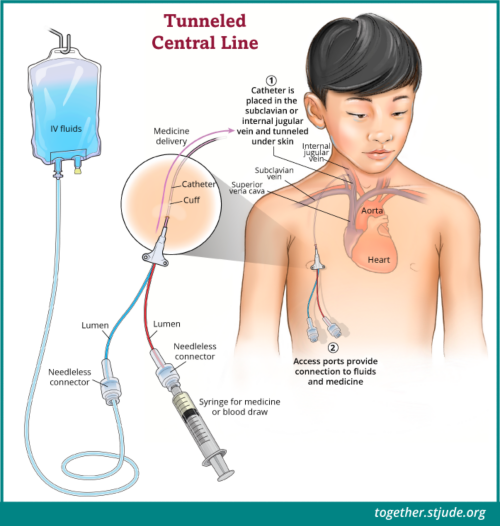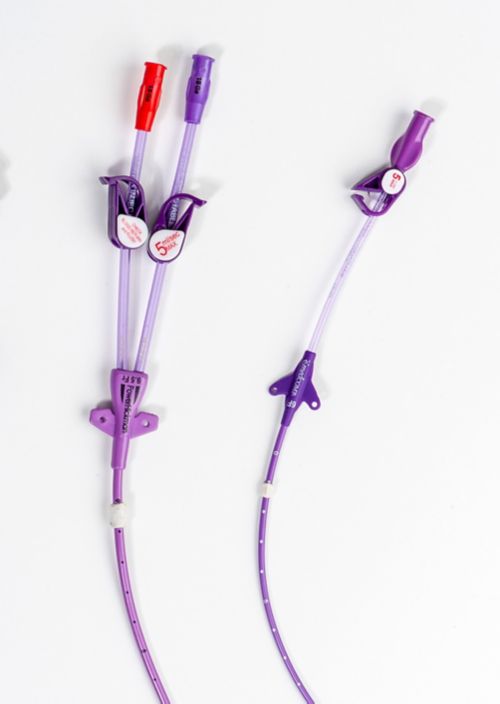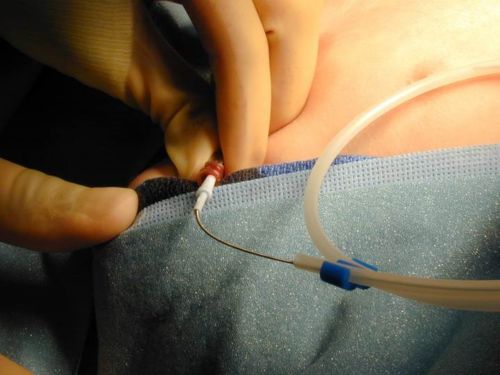What is a tunneled central line?
A tunneled central line (sometimes known as a tunneled catheter, Powerline®, Hickman®, or Broviac® catheter) is a central venous catheter that is tunneled under the skin. It is usually inserted into a vein under the collarbone (subclavian vein) or in the neck (jugular vein). It is guided through the vein until it reaches the correct place near the heart. The end of the catheter comes out through an opening in the upper part of the chest.
A tunneled central line allows medicines, nutrition, blood products, and fluids to be given into a large vein. Blood samples can also be taken.
One end of the catheter stays outside the skin and has one or two tubes called lumens. Each lumen has a cap called a needleless connector placed on the end. The connectors keep the lumens from leaking and keep air and bacteria out. The connectors allow medicines and fluids to be given without needle sticks.
A dressing is worn over the area to protect against infection. The dressing also helps keep the catheter in place. The catheter also has a Dacron® cuff around the tubing just under the skin on the chest to hold it in place and act as a barrier to infection. The cuff may be felt as a small bump under the skin.
Tunneling the catheter under the skin helps to lower the chance of infection. However, because part of the catheter stays outside the skin, there is a chance for bacteria to enter. With good care, the catheter can stay in place for months to years before it needs to be removed. It is important to follow all instructions to prevent infection and keep the line working properly.
Advantages of a tunneled central line
- A tunneled central line reduces the need for needle sticks for medication, fluids, nutrition, blood products, and blood samples.
- The device is easy to access.
- A central line can stay in place for a long time.
- Some medicines can irritate blood vessels. A tunneled central line is placed in a large vein with high blood flow so there is less irritation.
- With some types of central lines, more than one type of medication or solution can be given at the same time.
- A tunneled central line can often be used to give medication at home, making it easier for patients and families to continue therapy.
- A tunneled central line can be removed in the clinic.
Placement of a central line is a common procedure during treatment for cancer and some other medical conditions. It has important benefits for patients and families. However, there are always risks involved with anesthesia and surgery. The main risks during insertion include bleeding, puncture of a lung or blood vessel, blood clots, irregular heartbeat, nerve injury, and infection. After line placement, blood clots, movement of the catheter out of position, and infection are the most common complications. Serious complications are rare, but they do occur. Be sure to ask questions and follow all instructions given by the care team.
Placement of the tunneled central line
Children will receive general anesthesia for central line placement. They will not feel pain or be aware during the procedure. Patients will be given NPO instructions for limiting food and drink before the procedure. It is very important to follow these guidelines. The total time for the procedure is usually about 1-2 hours with anesthesia and recovery.
- Before the procedure, patients will have blood work and a physical exam. Members of the care team will meet with the family to complete paperwork and answer questions.
- The patient will be taken to an interventional radiology or operating room for the procedure. Depending on medical center policies, a parent may be able to go with the patient until time for the placement.
- Children usually receive general anesthesia for central line placement. Heart rate and blood pressure will be monitored throughout the procedure and recovery.
- The skin in the area will be cleaned, and a drape will be used to cover the patient’s body to keep the area clean and prevent infection.
- The vein will be located using ultrasound imaging or anatomical landmarks. A small cut will be made in the skin near the collarbone or neck. This is the entry site.
- Using a needle and guide wire, the catheter will be inserted through the entry site and guided through the vein under X-ray guidance. The tip of the catheter will stop just above the heart. Imaging is used to see the position of the catheter.
- The other end of the catheter will be tunneled under the skin and will exit the body through a small incision in the upper chest. This is the exit site. Stitches will be used to hold the catheter in place at the exit site.
- A short length of catheter will stay outside of the body. An end cap will be placed on the end of the catheter tubing where medication is given.
- After the central line is placed, it will be covered to keep it secure and clean.
- An X-ray will be used to check the position of the catheter and to make sure the lung was not injured (pneumothorax) during the procedure. A nurse will draw a small amount of blood to make sure the catheter is working properly.
- Recovery from central line placement usually takes about an hour. Patients will be monitored during this time. Before discharge from the hospital, a care team member will go over dressing changes and central line care.
Caring for a tunneled central line
Your care team will teach you how to care for the central line. Lines must be flushed daily with heparin. Heparin is a medicine that keeps the blood from clotting and blocking the line. A dressing is worn over the area to prevent infection and keep the catheter in place. The dressing should be changed once a week or if it gets wet, dirty, or comes off. It is important to keep the dressing from getting wet during bathing.
What should I expect after a tunneled central line?
Early healing
The area will be sore for a few days. There will be a few stitches where the tube goes in and out. There may be small amounts of blood on the dressing or bruising in the area. It may feel like the line is pulling on the outside of the skin. Complete healing takes 2-4 weeks.
Be careful when picking up your child under the arm on the same side as the central line. This may cause discomfort.
Getting medicine
Medications may be given with a syringe or an IV bag. Let a nurse know if you have any pain or discomfort while receiving your medications.
General care
Follow all care instructions to keep the line working properly and to prevent infection. Always wash your hands before touching the catheter. The needleless connector should be cleaned before each connection to the line.
Avoid activities that could damage the catheter, such as contact sports or rough play. You should not swim with a line because it might cause infection.
Make sure the line is secured, and keep a clean, dry dressing over the site at all times. Watch for signs of damage to the line.
A Central Line Associated Blood Stream Infection (CLABSI) can be life-threatening. Call your doctor at any sign of infection such as pain, redness, swelling, or fever.






